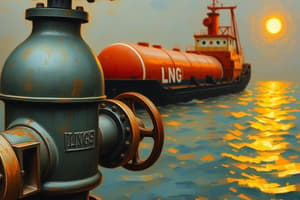Podcast
Questions and Answers
What is the correct course of action if there is flame impingement on a visible LPG/CNG storage tank?
What is the correct course of action if there is flame impingement on a visible LPG/CNG storage tank?
- Shut off the valve at the piping to prevent gas flow.
- Evacuate the area immediately and wait for emergency services.
- Allow the flame to continue burning without intervention.
- Take action to control the fire and cool the tank. (correct)
What can happen if a pressure relief device for an LPG or CNG tank fails?
What can happen if a pressure relief device for an LPG or CNG tank fails?
- Gas will vent harmlessly into the atmosphere.
- The energy will dissipate without any hazard.
- A BLEVE may occur. (correct)
- The tank will automatically shut down.
Which statement about LPG/CNG vehicle marking is accurate?
Which statement about LPG/CNG vehicle marking is accurate?
- All LPG/CNG vehicles are required to have fuel hazard markings.
- Vehicles may not be marked to identify this fuel hazard. (correct)
- Fuel hazard markings are optional but recommended.
- Markings are only required if the vehicle is over a certain weight.
If vapors escaping from a storage tank relief valve have ignited, what is the recommended action?
If vapors escaping from a storage tank relief valve have ignited, what is the recommended action?
How can the flow of gas through piping be controlled in an emergency?
How can the flow of gas through piping be controlled in an emergency?
Study Notes
LPG & CNG as Vehicle Fuels
- LPG (Liquefied Petroleum Gas) and CNG (Compressed Natural Gas) serve as alternative fuel sources for vehicles.
- Pressure release devices alongside these fuels can produce dangerous fire effects, including a "blow torch" incident.
Safety Hazards
- Failure of pressure relief devices can result in a BLEVE (Boiling Liquid Expanding Vapor Explosion).
- Vehicles using LPG/CNG may not display standard hazard markings, increasing risk during emergencies.
Emergency Response Actions
- If flames are affecting a visible LPG/CNG storage tank, prioritize fire control and cooling the tank.
- Engage emergency shutoff controls to halt gas flow from the storage tank when possible.
Fire Management
- In scenarios where vapors from a storage tank's relief valve ignite, allow combustion while mitigating risks to surrounding areas and cooling the tank.
- Gas flow through piping can be managed by shutting valves at the storage tank to prevent further gas release.
Hazard Assignment
- The situation should maintain a balance of 2 & 1 hazardous assignment to ensure safety during responses to LPG/CNG incidents.
Studying That Suits You
Use AI to generate personalized quizzes and flashcards to suit your learning preferences.
Description
This quiz covers the safety protocols and emergency procedures related to the use of LPG and CNG as vehicle fuels. Learn about pressure release devices, risks associated with BLEVE, and actions to take in the event of a fire. Test your knowledge on identifying hazards and operating emergency controls.




